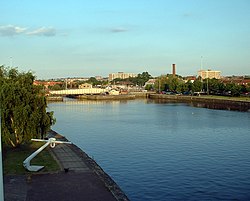Cumberland Basin (Bristol)
| Cumberland Basin | |
|---|---|

The basin looking eastwards
|
|
| Location within Bristol | |
| Coordinates: 51°26′53″N 2°37′10″W / 51.44806°N 2.61944°WCoordinates: 51°26′53″N 2°37′10″W / 51.44806°N 2.61944°W | |
| Country | England |
| City | Bristol |
| District | Hotwells |
| Established | 1804-9 |
The Cumberland Basin is the main entrance to the docks of the city of Bristol, England. It separates the areas of Hotwells from the tip of Spike Island.
The River Avon never flowed through the Cumberland Basin. Before the 19th century improvements and the construction of the non-tidal Floating Harbour, the Avon flowed through the tidal harbour and out through the future location of the Underfall Yard. When the basin and Floating Harbour were constructed the river was diverted through the New Cut, bypassing the harbour entirely.
Following competition from other ports, in 1802 William Jessop proposed installing a dam and lock at Hotwells to create the harbour. The £530,000 scheme was approved by Parliament, and construction began in May 1804. The scheme included the construction of the Cumberland Basin, a large wide stretch of the harbour in Hotwells where the Quay walls and bollards have listed building status.
The new scheme required a way to equalise the levels inside and outside the Dock for the passage of vessels to and from the Avon, and bridges to cross the water. Jessop built Cumberland Basin with two entrance locks from the tidal Avon, of width 45 ft (13.7 m) and 35 ft (10.7 m), and a 45 feet (13.7 m) wide junction lock between the Basin and what became known as the Floating Harbour. This arrangement provided flexibility of operation with the Basin being used as a lock when there were large numbers of arrivals and sailings. The harbour was officially opened on 1 May 1809. The first alteration was the construction of the south junction lock which was completed in 1849 and had a single-leaf wrought-iron gate. It is no longer used and has been sealed by a concrete wall.
In 1831 a terrace of eight houses were built for the Bristol Docks Company. In 1870 a hydraulic pump house was built by Thomas Howard to power the bridges and machinery. It has since been converted into the Pump House pub, with hydraulic power being provided from the Hydraulic engine house at the Underfall Yard.
...
Wikipedia

